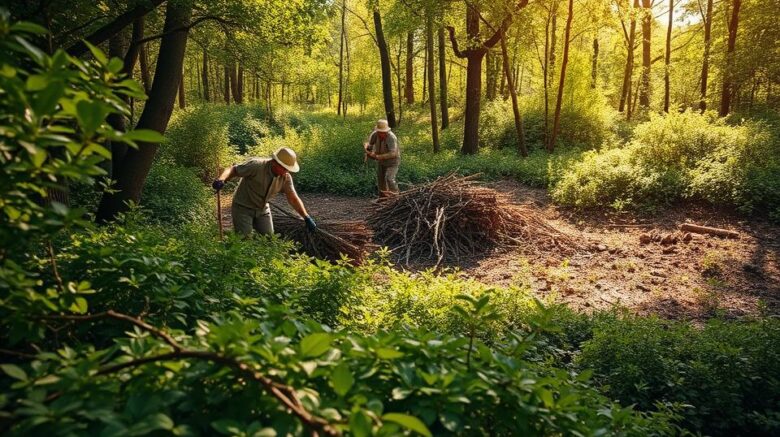Land Clearing Encircling Water Sources: Optimal Methods
Are you aware of nearly 70% of the planet’s freshwater resources are threatened by agricultural runoff and Land Clearing? Such a sobering number emphasizes the urgent need for responsible land management, essential during water source Land Clearing. Maintaining environmental responsibility is key to preserving ecosystem equilibrium and protecting aquatic purity and wildlife habitats. With increasing resource demands from communities, adopting sustainable land management practices is indispensable. This approach promotes project success while mitigating soil erosion and minimizing pollution threats in aquatic ecosystems – land clearing services.
Critical Summaries
- Sustainable land management is essential for protecting water quality.
- Implementing best practices can prevent soil erosion and habitat loss.
- Understanding ecological impacts is essential for responsible Land Clearing.
- Thoughtful planning boosts project success while protecting ecosystems.
- Utilizing effective techniques promotes biodiversity in aquatic landscapes.
Comprehending Sustainable Land Clearing’s Importance
Land Clearing extends beyond plant removal. It has ecological effects of Land Clearing that can affect adjacent zones, particularly aquatic ones. Conventional approaches typically lead to soil erosion, habitat disruption, and water contamination. Recognizing these impacts is essential for embracing superior land management.
Environmental Consequences of Typical Land Clearing
Standard Land Clearing methods can cause many environmental issues. Loss of vegetation results in soil erosion, soil degradation, and sediment runoff into aquatic systems. Such runoff contaminates water bodies, jeopardizing aquatic ecosystems. It also threatens local wildlife and disrupts the ecosystem’s balance.
Sustainable Land Management Options
Implementing sustainable land management practices mitigates problems of standard clearing. Selective clearing, where specific plants are removed, preserves ecosystem balance. Employing erosion control strategies—such as cover cropping—stabilizes soils and safeguards water purity. Emphasizing indigenous vegetation bolsters wildlife and fosters ecological well-being.
Key Best Practices for Land Clearing
Effective Land Clearing begins with thorough comprehension of environmental aspects. It’s vital to assess environmental goals to ensure clearing efforts are effective and sustainable. By setting clear objectives, landowners can make decisions that balance environmental preservation with development needs.

Evaluating Your Environmental Objectives
Prior to initiating any clearing work, evaluating environmental goals is vital. This involves evaluating the local ecosystem and how clearing might affect wildlife, soil, and water. Defining personal objectives aids in crafting strategies to safeguard local habitats and watersheds.
Selecting the Optimal Time for Clearing
The timing of Land Clearing is key to its success. Winter and early spring are ideal, as the ground is frozen, reducing soil disturbance and erosion risks. Understanding avoidance periods results in healthier landscapes and diminished environmental impact.
Evaluating Local Regulations and Permit Requirements
Following local Land Clearing regulations is necessary for successful projects. Knowing permit prerequisites helps prevent legal troubles or penalties. Checking ordinances around protected sites ensures compliance and avoids disasters.
Land Clearing Near Water Sources: Prime Techniques
Clearing strategies around aquatic sources emphasize safeguarding sensitive zones and preserving ecological equilibrium. A detailed strategy includes locating sensitive zones and using proper erosion control techniques. Such actions are vital to conserving biodiversity and water quality.
Pinpointing Critical Areas for Protection
Before initiating Land Clearing, it is essential to assess the landscape for sensitive areas such as wetlands and riparian zones. These unique ecological zones play a vital role in filtering pollutants and providing habitat for various species. Proper identification enables land managers to implement safeguards during and post clearing.
Implementing Erosion Control Measures
After identifying critical areas, using erosion control tactics prevents sediment from entering water bodies. Techniques such as silt fencing, natural buffers, and planting cover crops contribute significantly to maintaining water quality. Emphasizing sustainable Land Clearing practices in combination with these erosion control measures fosters a healthier ecosystem around water resources. Such practices support environmental health and community well-being.
Comparing Mechanical and Manual Clearing
Choosing between mechanical and manual Land Clearing methods is critical. Both methods present benefits and drawbacks affecting ecosystems and operational efficiency. Understanding these differences helps landowners make informed decisions, aligning with their land management goals.
Advantages and Disadvantages of Mechanical Clearing
Mechanical Land Clearing employs heavy machinery to swiftly remove trees, shrubs, and debris. It leads to quicker project completion and less physical labor. Yet, machinery use can cause significant soil disturbance, compaction, and damage to ecosystems.
- Benefits: Efficiency in clearing large areas.
- Lower manual labor expenses.
- Suitability for challenging terrains.
- Cons: Heightened environmental footprint.
- Potential for soil erosion.
- Potential habitat damage.
Benefits of Manual and Selective Clearing
Manual and targeted clearing emphasize eco-sustainability. Using trained workers, targeted removal reduces soil disruption and safeguards vegetation. Such practices are preferred for biodiversity conservation and ecosystem well-being.
- Benefits: Preservation of native vegetation.
- Reduced soil disturbance and erosion.
- Improved wildlife habitat preservation.
Methods for Wetland Clearing
Wetland ecosystems are distinctive habitats vital for ecosystem stability. They purify water, mitigate flooding, and serve as habitats for diverse life forms. Understanding these ecosystems is key to responsible wetland clearing practices. The aim is to reduce disturbances and protect these crucial aquatic zones.
Understanding Wetland Ecosystems
Wetlands feature specific hydrologic conditions, soils, and flora. They act as interfaces between land and water, sheltering multiple species. They regulate water quality via natural filtration processes that extract contaminants. Protecting these zones supports biodiversity and strengthens ecosystem resilience.
Techniques for Responsible Wetland Clearing
Careful planning and precise execution underpin responsible wetland clearing. Sustainable methods can reduce the adverse effects of clearing. Some commonly adopted strategies include:
- Staged Clearing: Conduct clearing in phases to minimize ecological disruption, allowing time for wildlife to adapt.
- Targeted Clearing: Remove only specific vegetation types, preserving critical species for habitat stability.
- Encouraging Regrowth: Introduce practices that encourage natural vegetation regrowth after clearing, maintaining ecosystem functions.
- Buffer Zones: Establish buffer areas around sensitive wetland sections to protect aquatic habitats from disturbances.
Implementing these techniques confirms that wetland clearing upholds ecosystem services and curbs habitat destruction.
Protecting Riparian Reserves During Land Clearing
Riparian reserves are crucial for healthy water ecosystems. Positioned beside rivers and streams, these zones function as protective buffers. They maintain water purity and foster biodiversity. By adopting best practices, land managers can prevent erosion, protect wildlife habitats, and preserve waterway ecological integrity.
Riparian Buffer Functions
Riparian buffers are key to supporting aquatic ecosystems. They trap pollutants, secure shorelines, and furnish habitats for wildlife. They serve as barriers that lessen human impact on aquatic systems. Preserving these zones boosts water quality and supports fish and aquatic life, enhancing ecosystem resilience.
Best Practices for Maintaining Riparian Zones
Key practices for riparian zone care include:
- Avoid construction within buffer strips to minimize disturbance.
- Use native vegetation to stabilize banks and prevent erosion.
- Establish a diverse plant community to enhance habitat complexity and support wildlife.
- Manage invasive species to protect native plants and maintain ecosystem stability.
- Regularly assess soil health and water quality to guide management efforts.
Importance of Aquatic Land Clearing Strategies
Aquatic clearing strategies help maintain ecosystem harmony and water quality. Managing water quality effectively during clearing minimizes pollution risks and supports sustainability. Such methods curb sediment runoff and bolster aquatic ecosystem health.
Water Quality and Sediment Management Tactics
Proper water quality control begins with evaluating local water systems. Clearing adjacent to water systems must avoid sediment deposits that damage water quality and aquatic organisms. Strategies include:
- Establishing buffer zones to filter pollutants
- Using sediment traps and barriers to minimize runoff
- Selecting clearing times to coincide with low water levels
These methods protect water quality and maintain ecosystem integrity. Remaining vegetation supports sediment retention and nutrient dynamics, promoting healthy waterways.
Aquatic Biodiversity Protection
Maintaining biodiversity in aquatic landscapes is key for resilient ecosystems. Water source clearing must conserve native species essential to ecosystems. Steps to boost biodiversity include:
- Conserving critical habitats during clearing processes
- Implementing phased clearing to allow wildlife adaptation
- Restoring natural vegetation post-clearing to enhance habitat
By adopting these measures, land managers can foster biodiversity in aquatic landscapes. This leads to more robust and adaptable ecosystems. These efforts safeguard water health and endorse sustainable land-use methods.
Stream Bank and Riverbank Clearing Insights
Stream bank clearing presents specific challenges that demand ecological and regulatory consideration. Respecting riverbank guidelines is vital to maintain water source ecosystem balance. Addressing erosion, habitat disruption, and water contamination requires targeted solutions.
Obstacles in Stream Bank Clearing
Stream bank clearing involves various challenges. Erosion is a major concern, causing soil loss and water quality deterioration. Habitat disruption impacts local wildlife, which depend on riparian zones. Lacking vegetation, stormwater flow intensifies, causing sediment buildup in streams. Such problems underscore the importance of managing stream banks effectively.
Mitigating Erosion and Supporting Healthy Flora
Addressing erosion is critical during stream bank clearing. Using indigenous vegetation fortifies banks. Roots curtail erosion, supporting a resilient environment for adjacent flora and fauna. Regular assessments during clearing ensure methods are effective, keeping riverbank considerations central to environmental care. Lush vegetation advances management objectives and sustains ecosystem health.
Conclusion
Following best practices in water source Land Clearing is critical to ecosystem well-being. Stakeholders should emphasize sustainable land management. This strategy achieves project aims while safeguarding the environment. Strategic planning and execution help protecting aquatic ecosystems and biodiversity during clearing.
Spotting vulnerable areas and employing erosion measures are crucial steps. Employing both mechanical and manual clearing methods helps landowners and contractors achieve responsible land management. Sustainable practices foster harmony between development and nature. This keeps water sources and nearby landscapes healthy and robust.
Sustainable land management is a shared duty. Each clearing activity influences watershed health. Integrating eco-responsible practices allows a future of harmonious agriculture and nature.
